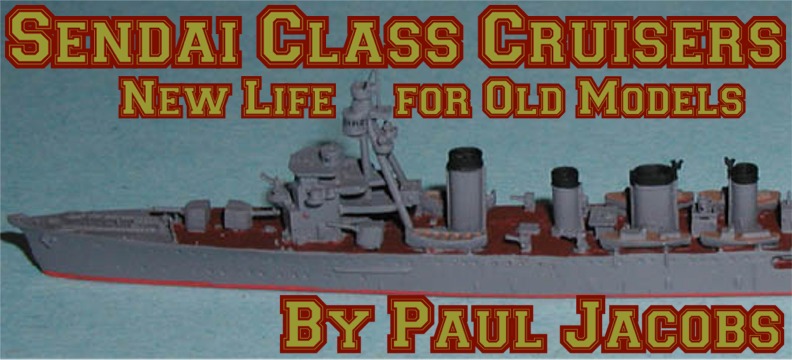 |
 |
I have always liked the Japanese Sendai Class cruisers, possibly because of their sleek hulls and four funnels, and perhaps because, more than fifty years ago, the Comet Sendai was one of the first 1:1200 scale models that I ever got. The Comet model was actually one of their better ones, and in the early 1960's after Comet/Authenticast ceased production, Superior copied it and, with some changes, continues to produce it. In 1971, Neptun released its models of the Sendai and Naka, and they have remained as the last models of the class to be released in 1: 1200/1250 scale ever since.
Recently I picked up the Neptun Sendai (N 1244) and Naka (N 1244A) second hand; both were inexpensive, as they had aging and damage, albeit very minor. My first idea was to modify both to represent the ships as built or at least as they looked in their early years, but after a review of the historical record, photos and plans, it became clear to me that such a modification would require far more cutting and grinding than I wanted to do. On to plan B: both ship models represent the vessels as they were in the late 1930's. But both ships underwent changes thereafter. Sendai had relatively minor changes made before her loss in 1943: the removal of number five 5.5" gun, and the addition of more anti-aircraft guns, and radar. Naka and sister Jintsu had structural changes however. In late 1941, both emerged from refits in which the forward torpedo tubes were removed, the forward torpedo flats were enclosed and roofed over and the after twin tubes replaced with triples. Jintsu was sunk in this state in 1943. Naka, which suffered torpedo damage in 1942, returned to Japan and underwent a more substantial refit emerging in 1943 with an enhanced anti-aircraft battery, removal of some guns and a variety of other changes and additions.
In light of the above and based upon my research materials, I redid Sendai as she was in 1943 and turned Naka into Jintsu 1942. The photos here illustrate the progression. Neither model was difficult to do, the most significant piece of work illustrated by the enclosed torpedo flat on the Jintsu.
Aside from the removal of number five gun on Sendai and the addition of the radar and 25 mm triple guns over the after torpedo flats, I made two other changes. First, I removed the forward funnel, because I consider the one on the model to be too fat. It should be the same size as the second and fourth funnels. This proved easier than I had expected. Using my Dremel tool I cut it off just above the boats and then ground the stub down to deck level. Second, the aircraft crane on the mainmast, although undamaged, was replaced, because, unlike her sister ships, Sendai had a simple pole type of boom. The original models came with plastic masts. But the second hand models had lost theirs and I made new ones from brass rod. Both of these conversions were simple and completed within hours. Tools needed: Hobby knife, Dremel, pin vice, tweezers, AC glue, sand paper, and metal files. All parts were made using Evergreen and Plastruct plastic sheet and rod, and Detail Associates brass rod.
Sources:
Japanese Cruisers of the Pacific War by Lacroix and Wells
Maru Special #27: Sendai, Naka, Jintsu
Drawings of Imperial Japanese Naval Vessels 2, Vol. 7.